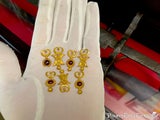- Authentic Jewelry
- >
- Artifact Jewelry
- >
- 4th CENTURY BC INDO-BACTRIAN GOLD NECKLACE PENDANT ANCIENT ARTIFACT (7 GARNETS)
4th CENTURY BC INDO-BACTRIAN GOLD NECKLACE PENDANT ANCIENT ARTIFACT (7 GARNETS)
4th century BC. A group of seven gold and garnet pendants from a necklace: four set with garnet cabochons with crescentic terminals terminating in granulated clusters; three comprising four-petalled flowers, also with crescentic terminals with granulated clusters to one end and spherical terminals to the other.
See Carter, M.L., Goldstein, S., Harper, P.O., Kawami, T.S., Meyers, P., Splendors of the Ancient East, Antiquities from the al-Sabah collection, London, 2013, pp.182-183, for similar style (decoration on goblet and gold sword quillons set with garnets).9.42 grams total, 19-25mm (3/4 -1").
Ex property of a London lady; formerly from the David Lindhal collection since 1969; accompanied by an independent specialist report and valuation by graduate gemologist and jewelry expert Anna Rogers, GIA GG, BA, Gem-A, ref. no. 169983/07/12/2020.
The period of the Hunnish-Hephtalite domination in Bactria and Hindu Kush was rich in wonderful artifacts fabricated with gold sheet and wire, engraved and inlaid. Many objects were made with granulation and carved with cabochon garnets or flat-cut garnets, sometimes decorated with twisted wires. In this borderland province of the Sassanian Empire, the new Hunnic and Turkic invaders added to the previous artistic shapes the decoration of golden objects with brightly colored stones, fruit of the symbiosis among the Nomad Art of the Steppe (like Scythian and Sarmatian) with the Kushans, Greek, Roman, Iranian and Indian artistic tradition.







